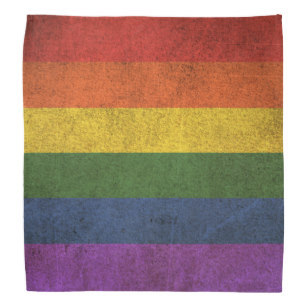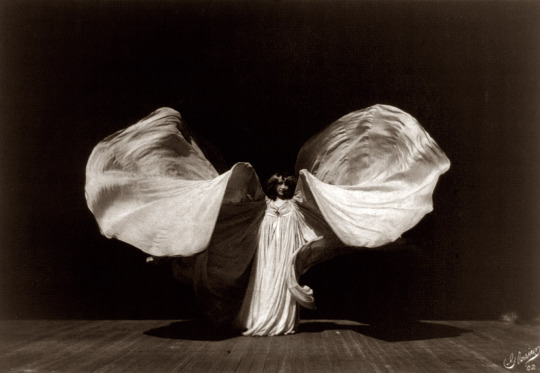#gab sorère
Explore tagged Tumblr posts
Text
so as a lot of people have pointed out in the notes already yes, it's a screenshot of a fake wiki article, and yes it is still funny anyway!
But just in case anyone's tempted to be disappointed - don't worry, artists & performers in the first half of the 20th century absolutely were being fun & weird & ambitious about radioactivity in their art!
Loïe Fuller was a dancer/choreographer & Lighting Design pioneer working in the US & Europe in the late 1800s & early 1900s - she & her partner, Gab Sorère, actively explored phosphorescence, blacklight, and different ways of getting fabric/costumes to glow for use in designs throughout their careers. Fuller was in direct contact with the Curies about potentially using radium onstage, and although that never came to fruition for her, she'd already found other ways to achieve similarly impressive effects in her famous Serpentine Dance (a slight tangent but wikipedia has a link to a clip of it filmed by the Lumière Brothers worth seeing), and in 1904 she still produced an effect-laden piece called Radium Dance, inspired by the phenomenon even if it didn't feature actual radium onstage.
This article includes an audience member's description of the performance:
[ ^ The author of that article, Lucy Jane Santos, has a book about more of the weirder uses of radium in pop culture called Half Lives: The Unlikely History of Radium, which is still on my to-read list. And as it mentioned, radioactive paint was unsurprisingly just as exciting for theatrical designers as it was for the more famous watch factories - though it seems unclear exactly how often the stage 'radium' was created using other effects. (though even the fact that false advertising like that would attract a crowd is an indicator of how much the concept captured public imagination at the time)]
Also, it might not be Plutonium Jazz, but Ziegfeld's Follies included a vaudevillian number called "My Radium Girl" in its 1915 iteration, the sheet music for which is freely available on the Library of Congress's website here. [I couldn't find a video of that song online, but the 1915 Follies's Overture is on youtube & the melody from that does make an appearance for about a minute around the 9:15ish mark if anyone's curious to hear it]
That same year, a musical revue titled The Radium Girl was touring Britain, with a plot focused around radium as a kind of magic potion, and featuring a script that called for 'radium effects' and a scene at 'the Radium Ball' in addition to the title number, although we don't know what the staging involved in this case, and I've never found the music anywhere.

#sorry for the tangent but before i even fact checked the og post i already had my radium girl playing in the back of my head#and i dont pass up opportunities to talk about historical lesbian theater technicians#it's one of my Rules#be thankful i didnt have my old lighting textbook within arm's reach or l might have gone on for longer#(also sorry if i gave the wrong timestamp for the song)#(i cant sight read & it's been a couple years since i heard it played)
46K notes
·
View notes
Photo


Gabrielle Bloch (deceased)
Gender: Female
Sexuality: Lesbian
DOB: 17 February 1870
RIP: 14 July 1961
Ethnicity: French
Occupation: Art promoter, set designer, mechanical innovator, choreographer, visual effects artist, producer
#Gabrielle Bloch#Gab Sorère#Gab Sorere#lgbt history#female#lesbian#1870#rip#historical#white#french#art promoter#set designer#choreographer#producer#popular#popular post
135 notes
·
View notes
Text
JANUARY 15: Loïe Fuller (1862 - 1928)
Marie Louise “Loïe” Fuller was born 155 years ago, on the 15th of January 1862 in the Chicago suburb of Fullersberg (now Hinsdale), Illinois.

Loïe Fuller, c. 1900, source
She is considered the most original, innovative pioneers in modern dance and lighting design, paving the way for artists such as Isadora Duncan or Martha Graham. But unlike others, she had no formal training in ballet or any classical dancing. Indeed she started her career as a child comedian and joined several travelling theatre companies, performing burlesque, vaudeville - she even toured with Buffalo Bill!
However she soon developed a passion for dancing, and choreographing her own dances inspired by Greek statues, using long veils and electrical lighting. Her major breakthrough came in 1892 in New York with The Serpentine Dance.

Loïe Fuller featured at the Folies Bergère
And yet, she decided to move to Paris that same year – and remained attached to France thereafter. The Parisian audience discovered her at the Folies Bergère, where she shook up the artistic scene - her performance was received as an embodiment of the Art Nouveau and the symbolist movement by the critics, who dubbed her the “Fairy of Light,” or “Fée Électricité.” Indeed she represented the general feeling of enthusiasm for scientific and technological progress of the Belle Époque.
She also became the muse of symbolists and Art Nouveau artists. Not only did she inspire artists such as Mallarmé, Toulouse-Lautrec, Rodin, Carabin, Harry C. Ellis, I. W. Taber, but she was also admired by scientists Marie and Pierre Curie, Guimard, Flammarion, and the Lumière Brothers... The architect Henri Sauvage built her a theatre-museum at the 1900 Paris Universal Exposition, where she performed and presented Japanese dancer Sada Yacco’s company.
However her success meant that she also had to deal with imitators. This is why later on she filed many patents and copyrights for her techniques and inventions regarding stage lighting, garments and accessories. She even became a member of the French Astronomical Society!

Frederick Glasier, Portrait of Loïe Fuller, 1902
Her style was unique. Indeed she elaborated her own movements and improvisation technique, her own style – a style which she felt was more natural than classical dance, focused on the motions of the arms rather than the feet, and was later named “free dance.” The movements of her body were amplified by huge costumes made of hundreds of yards of silk, which she often animated by holding two long bamboo or aluminium wand-like extensions. The translucent layers of fabric swirled around her in mesmerizing shapes and waves, enhanced by lighting effects from the sides of the stage, and from underneath her, when she danced on a plate of glass - she was always experimenting new ways of creating spectacular, magical effects.
youtube
The Serpentine Dance recorded in 1896 by the Lumière Brothers. Flower, mushroom, butterfly, fairy… What do you see?
She didn’t hide her feminist ideas and homosexuality. I won’t get into the topic of how the recent Loïe Fuller biopic obliterated that part of her life – a topic to which we will dedicate a whole article later this year.
Loïe Fuller created her own feminine world, surrounding herself with her students, called the “Fullerets” or Muses. Isadora Duncan wrote about her first encounter with Loïe, and described the older dancer amidst “dozen or so beautiful girls… alternately stroking her hands and kissing her.” Nonetheless, Loïe played an important part in Isadora’s success in Europe by sponsoring her spectacles.
She was briefly married to Colonel William Hayes, but after they separated in 1892, she only had lesbian relationships. She fell in love with her student and collaborator Gabrielle Bloch, also known as Gab Sorère and together they joined Natalie Barney’s salon, a circle of lesbian artists, where they befriended Romaine Brooks, Eileen Gray and Damia. All in all, Fuller and Bloch lived together for 23 years, till Loïe’s death in 1928.
- Lise
#365daysoflesbians#loie fuller#free dance#dance#lighting techniques#stage lighting#fée électricité#fée lumière#fairy of light#queer#queer history#wlw#lesbian#lesbian history#gab sorère#isadora duncan#queer woman#lgbt#lgbt history#us#france#19th century#20th century#people
195 notes
·
View notes